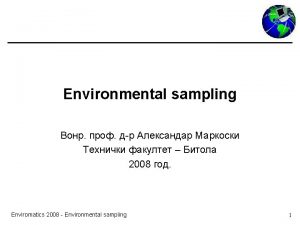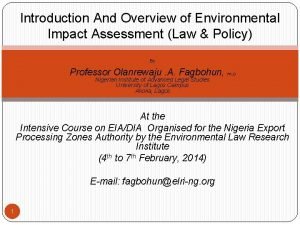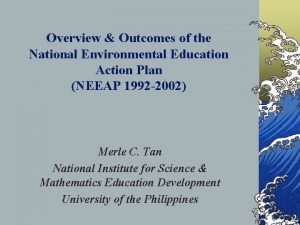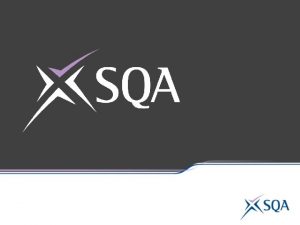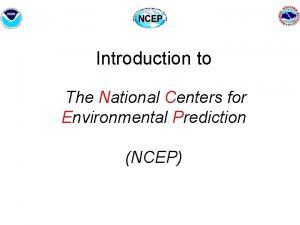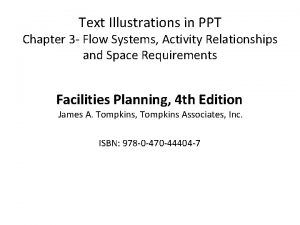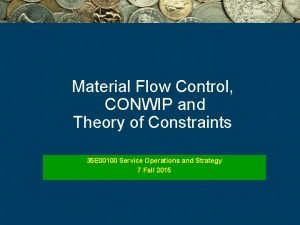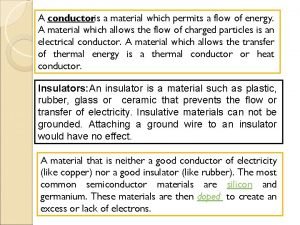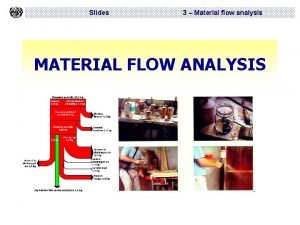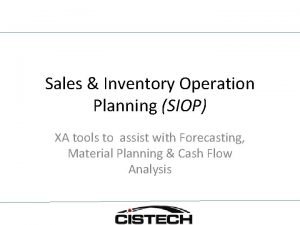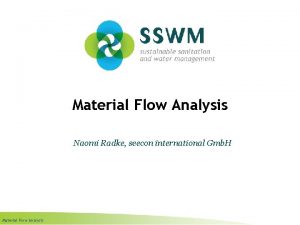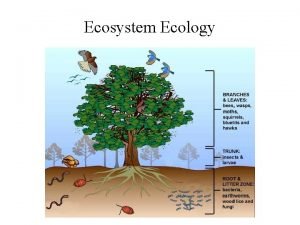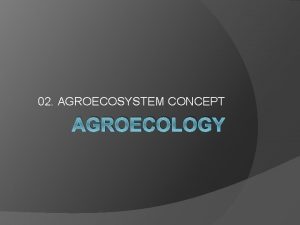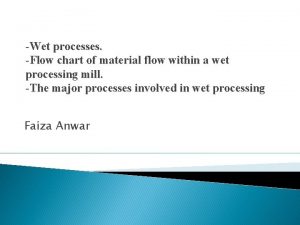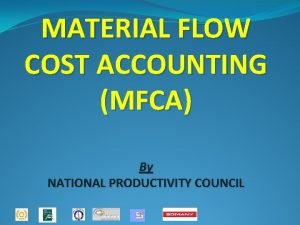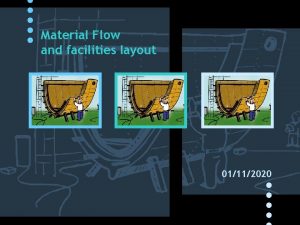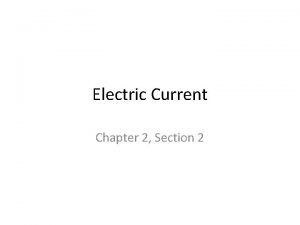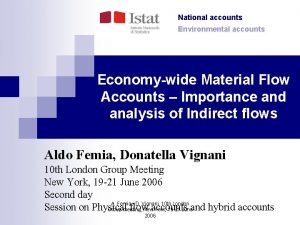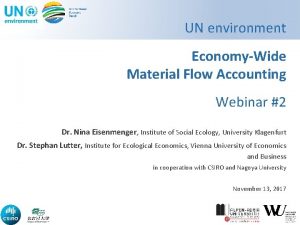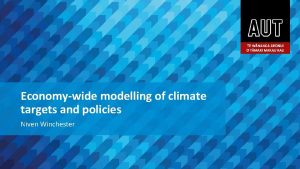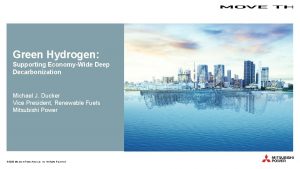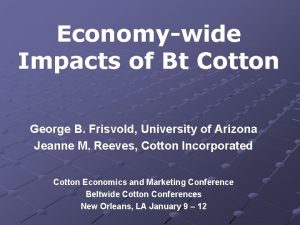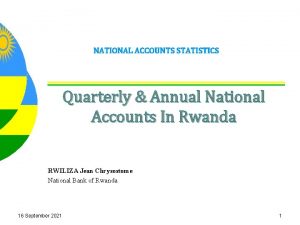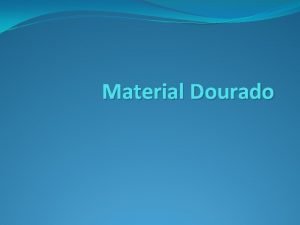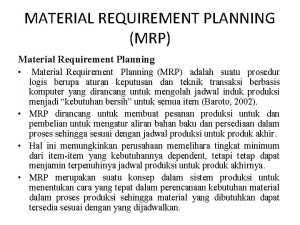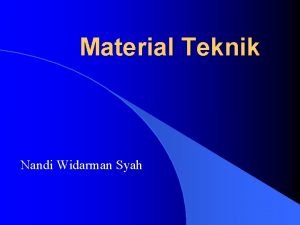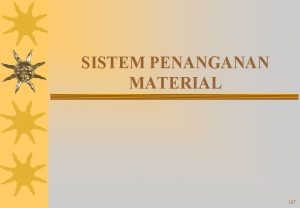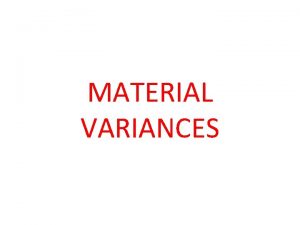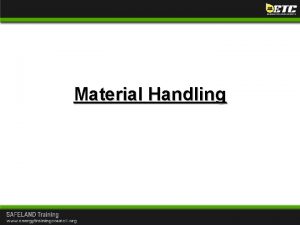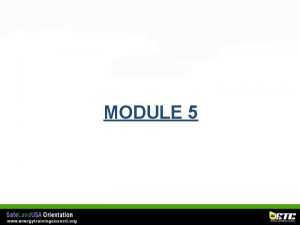National accounts Environmental accounts Economywide Material Flow Accounts

























- Slides: 25

National accounts Environmental accounts Economy-wide Material Flow Accounts – Importance and analysis of Indirect flows Aldo Femia, Donatella Vignani 10 th London Group Meeting New York, 19 -21 June 2006 Second day A. Femia - D. Vignani, 10 th London Session on Physical flow Group meeting, Newaccounts York, 19 -21 Juneand hybrid accounts 2006

A global target for Natural Resource Use Total Material Requirement (TMR) The Italian Environmental Strategy Action Plan for Sustainable Development suggests, among others, the target of a reduction of natural resources exploitation by 25% within 2010: this target is fixed in reference to the TMR, possibly in comparison with Gross Domestic Product (GDP) TMR is the widest indicator in the EW-MFA as it measures the total “material base” of an economy. A. Femia - D. Vignani, 10 th London Group meeting, New York, 19 -21 June 2006 National Accounts Environmental accounts

Empirical evidence for the long term-trend The TMR has grown by 21% from 1980 to 2003 A. Femia - D. Vignani, 10 th London Group meeting, New York, 19 -21 June 2006 National Accounts Environmental accounts

… and its components? Direct and Indirect flows A. Femia - D. Vignani, 10 th London Group meeting, New York, 19 -21 June 2006 National Accounts Environmental accounts

What are Indirect Flows associated to Imports They are the up-stream uses of resources necessary, in a life-cycle perspective, in order to realise the imported products, though not embodied in them. These are both used and unused natural resources that have been taken from the environment abroad. This matter has not been embodied in the products: it has been given back to the environment as residual matter (emissions to air and water, and waste). IF therefore also represent a proxy for the additional potential pressures activated by the demand for the products imported, avoided by the importing country. A. Femia - D. Vignani, 10 th London Group meeting, New York, 19 -21 June 2006 National Accounts Environmental accounts

The growth of Indirect Flows associated to Italian Imports, 1980 -2004 + 80% Slowdown of growth in 1993 - 2004: + 5, 3 % Italy can contribute to the reduction of resource use worldwide mostly by putting under control the foreign components of its TMR National Accounts A. Femia - D. Vignani, 10 th London Group meeting, New York, 19 -21 June 2006 Environmental accounts

Analytical setting: effects decomposition IF (IF/Ip) * (Ip/Iv) * (Iv/Y) * Y Imports’ Indirect Flows Average IFs activation per Imports’ physical unit Imports’ penetration (globalisation) Average Imports’ weight per unit value Level of economic activity (economic growth) A. Femia - D. Vignani, 10 th London Group meeting, New York, 19 -21 June 2006 National Accounts Environmental accounts

Focus: physical determinants Let us split the identity in two parts: IFtot (IFtot/Ip)*Ip and Ip (Ip/Iv)*(Iv/Y)*Y We will focus on the first part, and in particular on its first factor, after a quick look at the change of Ip and the way its drivers contributed to its change A. Femia - D. Vignani, 10 th London Group meeting, New York, 19 -21 June 2006 National Accounts Environmental accounts

Contributions of IF intensity and of Imports’ growth to overall IF growth Both components grow until the beginning of the 1990 s. Cumulated contribution, million tons of IF intensity of Imports (IF/Ip) of Imports’ growth (Ip) Overall change of Imports’ IF The cumulated contribution of IF intensity has peaks in 1993 and 1998, then decreases rapidly and in 2004 explains only 10% of overall IF growth. The tendency of Import’s growth contribution is quite steady. A. Femia - D. Vignani, 10 th London Group meeting, New York, 19 -21 June 2006 National Accounts Environmental accounts

Macro driving forces of physical Imports Economic growth + 53, 4 % 1980 -2004 Imports’ penetration (globalisation ) + 62, 9 % 1980 -2004 Average Imports’ weight per unit value (tertiarisation) A. Femia - D. Vignani, 10 th London Group meeting, New York, 19 -21 June 2006 -37, 3 % 1980 -2004 National Accounts Environmental accounts

IF Intensity: two sub-periods Ratio between indirect flows associated to imports and actual import flows, Italy, 1980 -2004 (tons per ton) The IF intensity of imports has grown throughout the 1980 s. It reached a peak in 1993 and then decreased, though not going back to the initial values. This is at the origin of IF’s growth slowdown from 1993 onwards. A. Femia - D. Vignani, 10 th London Group meeting, New York, 19 -21 June 2006 National Accounts Environmental accounts

How to decompose IF intensity The overall IF intensity can be seen as a weighted average: IF/Ip i (IF/Ip)i * (Ipi /Ip) Average IF intensity of component i of the Imports Share of component i on total Imports The disaggregation helps understanding the reasons for the trend A. Femia - D. Vignani, 10 th London Group meeting, New York, 19 -21 June 2006 National Accounts Environmental accounts

Dimensions of the analysis We analysed the following sub-periods: 1988 -1993: overall IF intensity grows from 3, 11 to 4, 15 1993 -2004: overall IF intensity falls from 4, 15 to 3, 13. What kind of changes determined this evolution? We tried to understand it by breaking down the Imports and their respective Indirect Flows: • by kind of material (i : B, F, M, P) • by geographical origin (i : countries) (for selected commodities only). • Environmental by. A. use : intermediate/final/mixed) Femia - destination D. Vignani, 10 th London(i Group meeting, New York, 19 -21 June 2006 National Accounts accounts

Analysis by kind of material Biomasses and products thereof on average 16% of imports and 9% of IFs Fossil fuels and products thereof on average 59% of imports and 14% of IFs Minerals and products thereof on average 24% of imports and 76% of IFs Composite products on average 1% of imports and 1% of IFs A. Femia - D. Vignani, 10 th London Group meeting, New York, 19 -21 June 2006 National Accounts Environmental accounts

Composition and intensity by material Sources of overall Imports’ IF intensity change 1988 -1993 (yellow) and 1993 -2004 (red) The two sub-periods display opposite trends. It is the change within the groups that explains most of the story. In the second sub-period the change in composition between the groups gives a tendency towards higher IFs. A. Femia - D. Vignani, 10 th London Group meeting, New York, 19 -21 June 2006 National Accounts Environmental accounts

The main component: minerals The share of minerals in Imports first decreased and then increased 1993 Minerals’ IF intensity but the intensity of their contribution to indirect flows had the opposite dynamics A. Femia - D. Vignani, 10 th London Group meeting, New York, 19 -21 June 2006 National Accounts Environmental accounts

Analysis of specific commodities’ IFs A subset of Minerals and products thereof : ores and precious metals representing 0, 9 % of total Imports, to which are associated 28, 9 % of total IFs on average in 19932004 Indirect Flows associated to Ores and precious metals’ Imports, million tons These flows decreased significantly A. Femia - D. Vignani, 10 th London Group meeting, New York, 19 -21 June 2006 National Accounts Environmental accounts

First-level determinants Profile of the overall volume of direct imports and of the average IF intensity of ores and precious metals A. Femia - D. Vignani, 10 th London Group meeting, New York, 19 -21 June 2006 National Accounts Environmental accounts

Overall shift-share effects on IF intensity Effect of changes of average IF intensities of individual commodities (due to the change of supplying country) Effect of changes of composition by commodity The change is due almost only to the shift between products, towards ores and minerals with lower average coefficients. Is this change also connected to changes in the countries that supply them? A. Femia - D. Vignani, 10 th London Group meeting, New York, 19 -21 June 2006 National Accounts Environmental accounts

Changing the sources of materials The sources of these materials have sensibly changed: more than 70% of the change in average intensity is due to the shift between continents A. Femia - D. Vignani, 10 th London Group meeting, New York, 19 -21 June 2006 National Accounts Environmental accounts

Change of continent Share in the italian Imports of ores and precious metals A. Femia - D. Vignani, 10 th London Group meeting, New York, 19 -21 June 2006 National Accounts Environmental accounts

Average intensity of ores’ imports from Africa Cumulated contribution of the shift within African countries as suppliers to the change of the average intensity for ores and precious metals, tons per ton As the share of quantities imported from Africa fell, their unitary upstream flows increased dramatically A. Femia - D. Vignani, 10 th London Group meeting, New York, 19 -21 June 2006 National Accounts Environmental accounts

Analysis by use destination 3 kinds of possible uses of imported goods: intermediate, final, both Contributions to overall Imports’ IF intensity change 1993 -2004 The change in composition by use destination by commodity favoured the growth of IFs. However, the overall tendency has been dominated by the changes within rather than between the groups. National Accounts A. Femia - D. Vignani, 10 th London Group meeting, New York, 19 -21 June 2006 Environmental accounts

Conclusions and discussion issue • Indirect flows are an important component, that should not be disregarded in a sustainability perspective for the globalised world • In spite of the uncertainties connected to their calculation, IFs have great communication power • It is possible to look behind macro-aggregated indicators (such as total IFs) and try and understand the dynamics that determine their evolution. • How should these be handled in the upcoming revision of the SEEA? A. Femia - D. Vignani, 10 th London Group meeting, New York, 19 -21 June 2006 National Accounts Environmental accounts

A. Femia - D. Vignani, 10 th London Group meeting, New York, 19 -21 June 2006 National Accounts Environmental accounts
 Wireless health
Wireless health Feature of size
Feature of size Material usage variance = material mix variance +
Material usage variance = material mix variance + Relativism
Relativism Whats cultural lag
Whats cultural lag Non material culture examples
Non material culture examples Materials that is useful and harmful
Materials that is useful and harmful Phases of data flow in environmental sampling
Phases of data flow in environmental sampling Environmental clearance process flow chart
Environmental clearance process flow chart Trgpol
Trgpol National 5 environmental science
National 5 environmental science National centers for environmental prediction
National centers for environmental prediction Material flow analysis ppt
Material flow analysis ppt Material flow control
Material flow control Material flow icon
Material flow icon The material that permits the flow of electricity
The material that permits the flow of electricity Material and information flow analysis
Material and information flow analysis Material and information flow analysis
Material and information flow analysis Naomi radke
Naomi radke Energy flow and material cycling in ecosystem
Energy flow and material cycling in ecosystem Energy flow and material cycling in ecosystem
Energy flow and material cycling in ecosystem Material flow chart
Material flow chart Reactive procurement
Reactive procurement Material flow cost analysis
Material flow cost analysis Material flow layout
Material flow layout A material through which charges cannot flow easily
A material through which charges cannot flow easily







